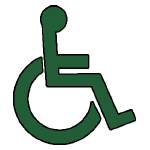September - May: Sunday Discipleship Hour | 9:00 am
Open Office Hours: Monday through Thursday | 9:00 am - 3:00 pm
Emergency Preparedness
Staff Liaison: Kurt Lutterman, Facilities Manager
Saint Andrew’s implemented an Emergency Operations Plan (EOP) in 2017. The plan’s purpose is to deter, mitigate and respond to incidents at Saint Andrew’s to minimize impacts on life and property.
Every room at Saint Andrew’s has an evacuation map near the door. On the back of the map are specific actions to take during incidents.
General response actions are also listed here.
Earthquake
- DROP – Drop to the floor. Get on your hands and knees.
- COVER – Get under a table, desk, chair, pew or any piece of furniture. Cover your head and neck with your hands and arms.
- HOLD – Grab a hold of that furniture.
When the shaking has stopped, refer to the evacuation map near the door of the room you are in. Using the Primary Evacuation Route (green arrow), calmly exit the building and muster in the bottom row of the parking lot. If the Primary route is blocked, use one of the Alternate Evacuation Routes (orange arrow).
Discussion
Standing in a doorway is old guidance, don’t do it. The above Best Practices are intended to shield you from falling objects such as broken window glass or ceiling light fixtures and to protect your head and neck. The HOLD (or HOLD ON) guidance is that the piece of furniture may be moving across the floor during a large earthquake. You want to move with it!
Here is a fun video demonstrating these Best Practices:
Fire
If you see a fire, pull the red FIRE ALARM pull handle at any exit door. This will trigger the fire alarm:
throughout the building. The fire alarm can also be automatically triggered by a smoke alarm or automatic fire sprinkler spraying water. The Fire Department is automatically called if the alarm is going off.
Refer to the evacuation map near the door of the room you are in. Using the Primary Evacuation Route (green arrow), calmly exit the building and muster in the bottom row of the parking lot. If the Primary route is blocked, use one of the Alternate Evacuation Routes (orange arrow).
Discussion
Nothing has changed in fire response Best Practices in any of our lifetimes. Remember your elementary school drills: exit the building calmly and deliberately. All building occupants gather in the bottom row of the parking lot so everyone can be accounted for, and Fire Department vehicles can use the upper two rows.
Police Response (actual or potential violence)
A police response incident is indicated by a police car siren sound and rotating red lights on the round white alarms throughout the building
The Best Practices are to:
- RUN – If you know the location of the violence, and can run away from it (rather than running into it inadvertently), run as fast as you can to the far corner of the outer Mormon temple parking lot (Southeast of Saint Andrew’s).
- HIDE – If you can’t run, hide where you are. Shut and lock doors, shut windows, turn off the lights. Crouch along walls. Remain silent.
- FIGHT – Only as a last resort, if you cannot avoid the offender, disrupt the offender: throw books, objects, use pepper spray, keep moving.
Discussion
We use the phrase police response to include any incident of actual or potential violence where a police response would be appropriate. The incident could be as simple as one person raising their voice to another, or as horrific as an active shooter incident. To minimize the harm to persons and property, the response actions are the same: Run, Hide, Fight.
If you witness an actual or potential violence incident at Saint Andrew’s, please err on the side of safety and initiate a police response.
You can initiate a building-wide police response by pushing one of the blue POLICE buttons at any exit door or in the Fellowship Hall by the Kitchen: lift the protective cover, hold the button for two seconds, wait for the alarm to sound.
Once activated, the police response will automatically:
- sound the police siren alarm and rotating red lights throughout the building,
- place the exterior doors into lockdown (people can still exit, but cannot enter, even with a door fob),
- alert the alarm monitoring company to call 911, and
- send text messages to church staff, other building occupants, Sunday Church School teachers, and other congregation members that choose to be notified.
If you would like to be added to this congregation member police response text notification, ask the Facilities Manager to include you.
Below is the official Federal Emergency Management Agency (FEMA) video demonstrating the above Best Practices. WARNING: This video deals with situations that may not be appropriate for children.
Related Activities
Sunday Worship | 10:00 am
In-Person AND Livestream
September-May: Sunday Discipleship Hour | 9:00 am
Classes for age 2 – adults
Worship Times, Map, and Directions
Saint Andrew’s Lutheran Church
2650 148th Avenue SE
Bellevue, Washington 98007
425-746-2529 phone
425-746-3758 fax
info@SALC.church
Office Hours: 9:00 am – 3:00 pm Monday – Thursday. Closed on legal holidays.
Pages focused on families:
We are an ELCA congregation and part of the Northwest Washington Synod
We are a Reconciling in Christ congregation

Use of content, including images, is prohibited without permission of Saint Andrew's Lutheran Church.


